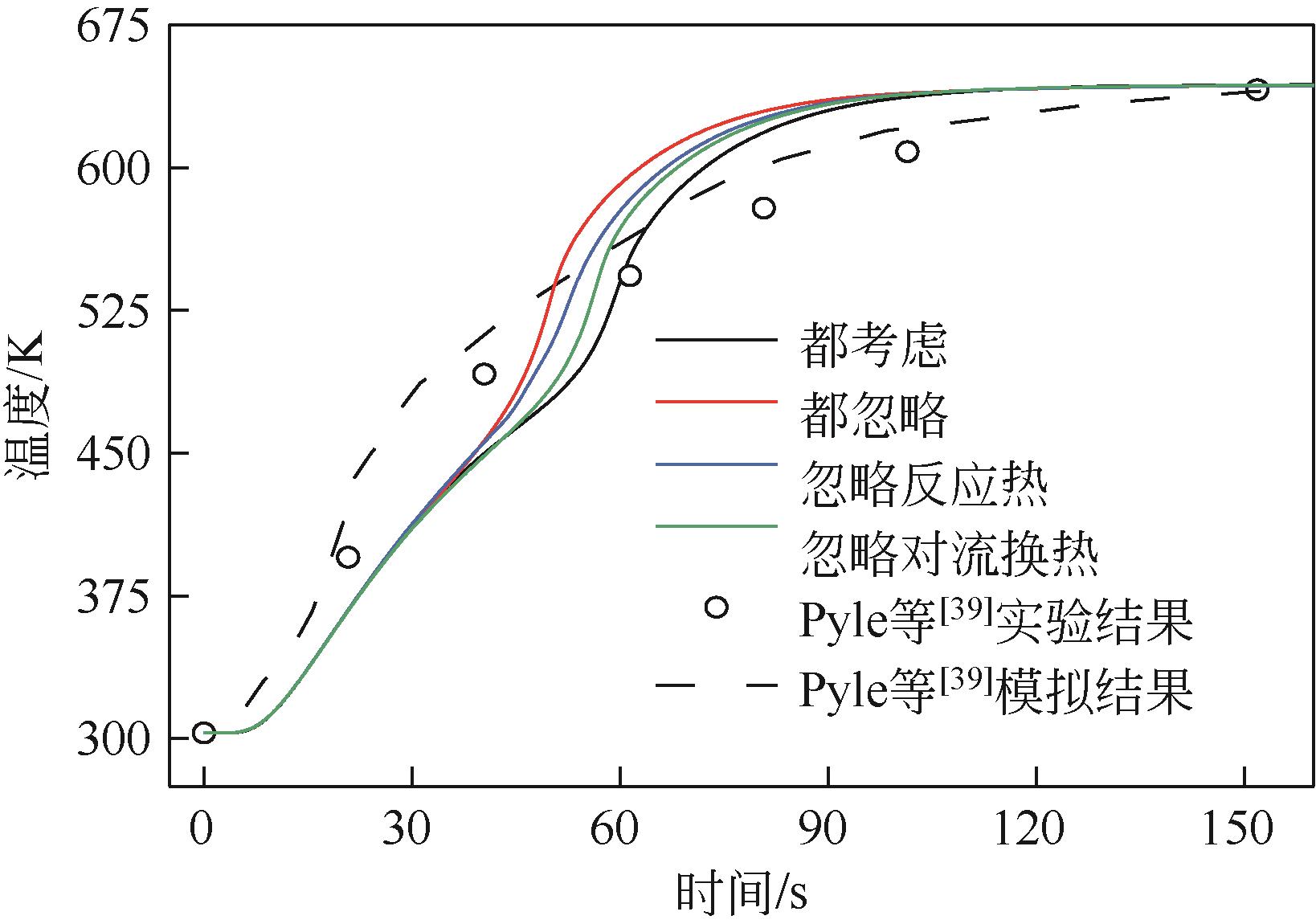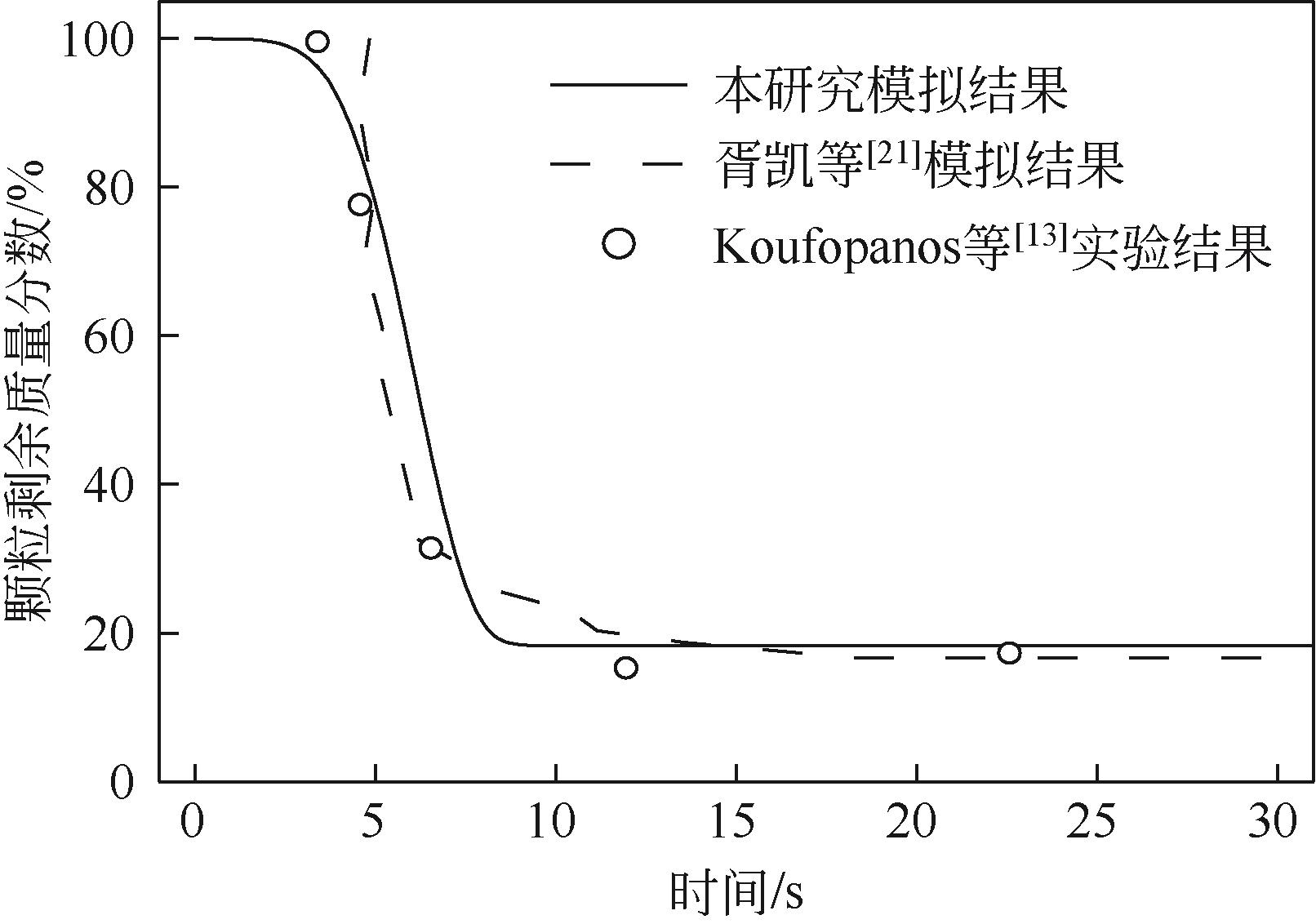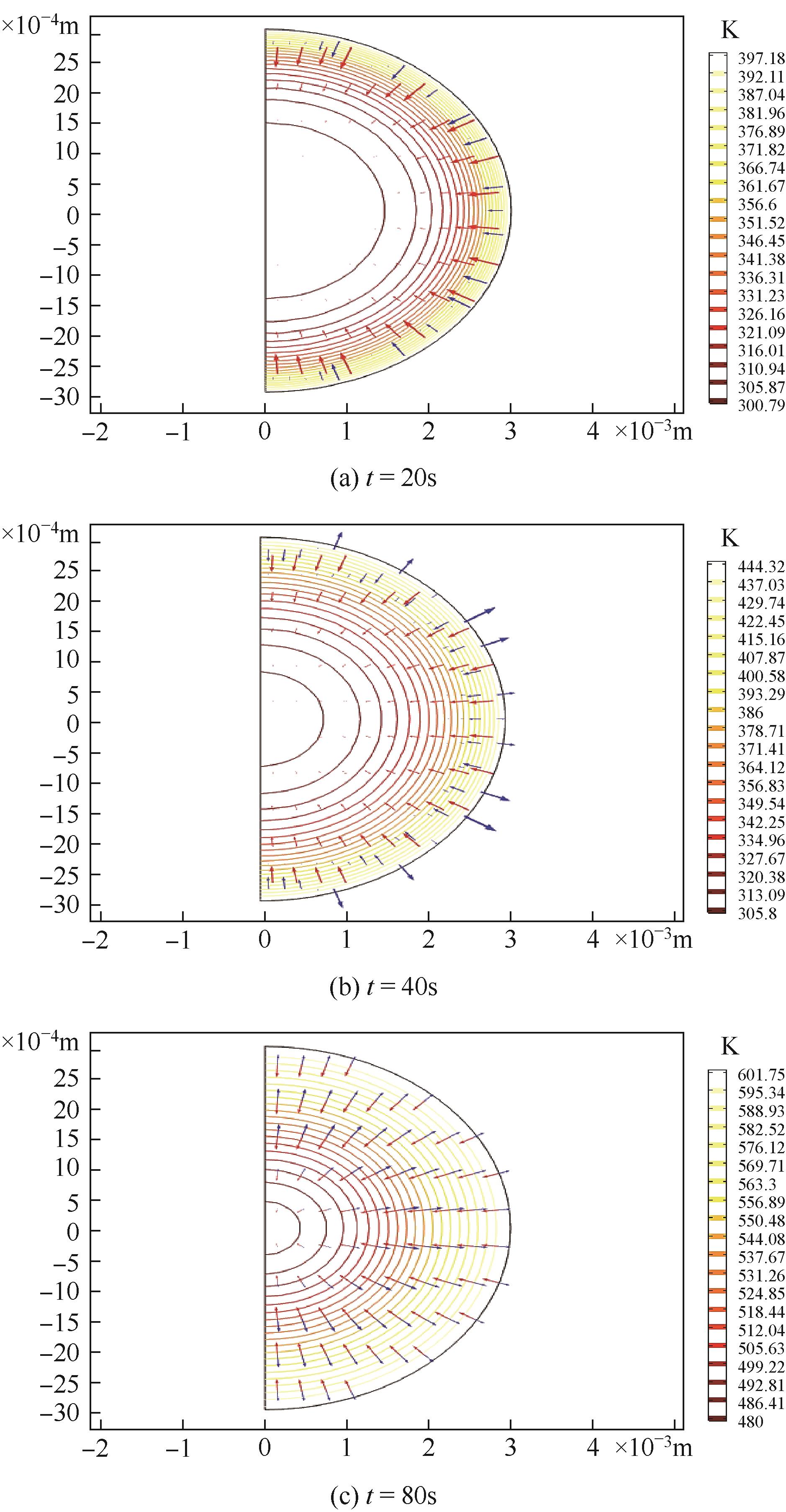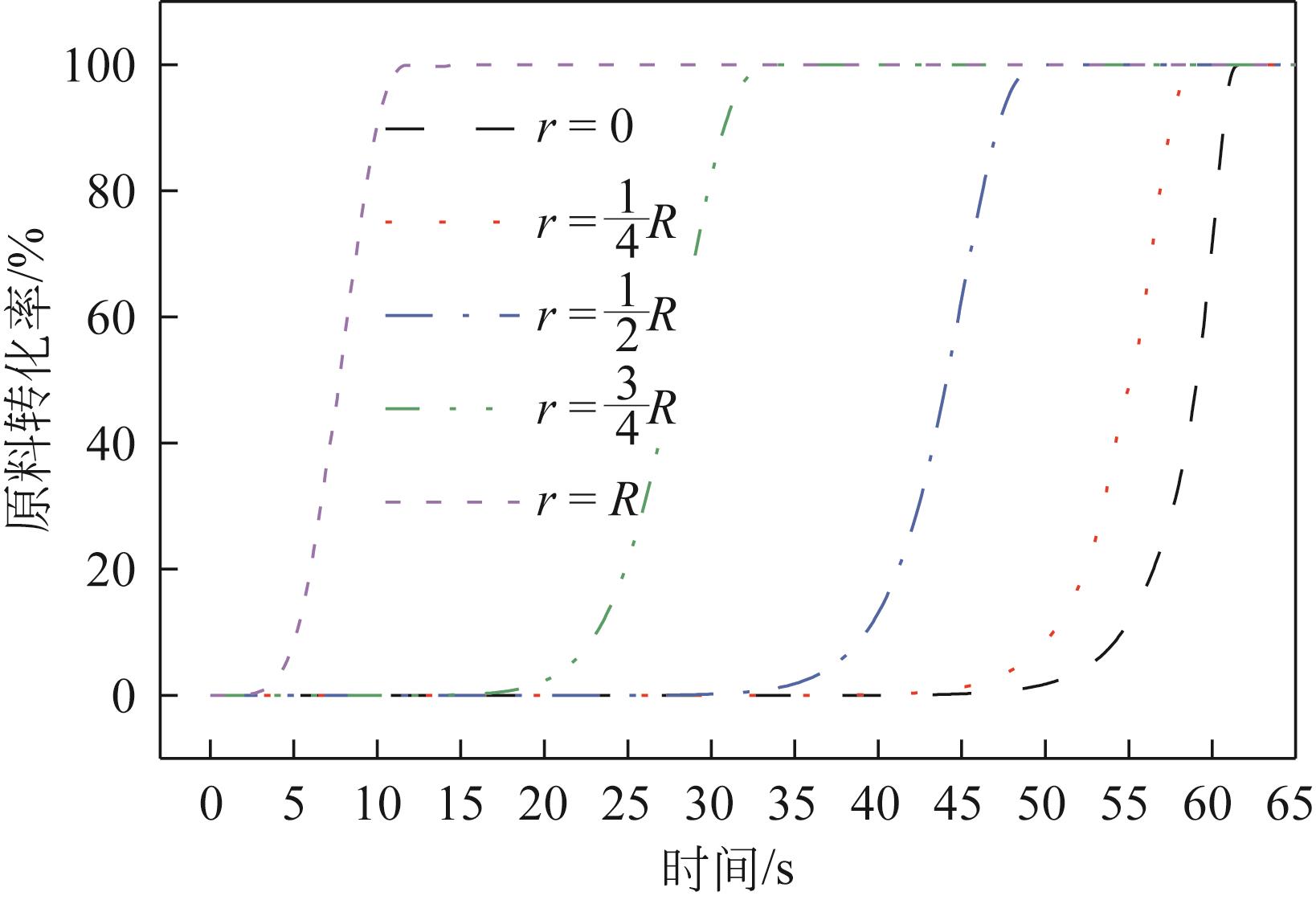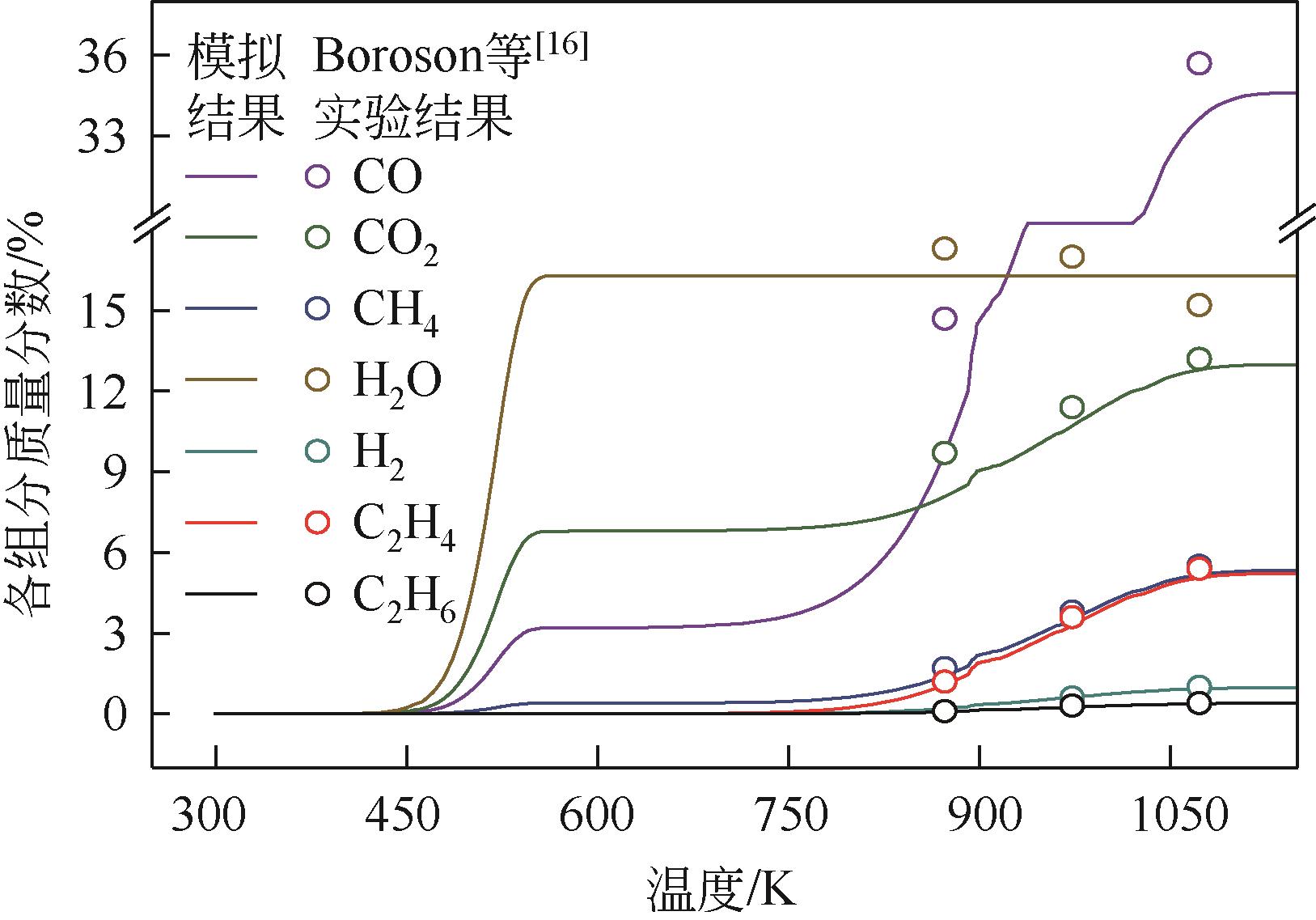Chemical Industry and Engineering Progress ›› 2022, Vol. 41 ›› Issue (12): 6245-6254.DOI: 10.16085/j.issn.1000-6613.2022-0337
• Chemical processes and equipment • Previous Articles Next Articles
Rule of heat and mass transfer during the pyrolysis process of pine sawdust particles
XUE Xiaohui( ), YUAN Mengli, SONG Yuncai(
), YUAN Mengli, SONG Yuncai( ), FENG Jie(
), FENG Jie( )
)
- State Key Laboratory of Clean and Efficient Coal Utilization, Taiyuan University of Technology, Taiyuan 030024, Shanxi, China
-
Received:2022-03-07Revised:2022-05-18Online:2022-12-29Published:2022-12-20 -
Contact:SONG Yuncai, FENG Jie
松木屑颗粒热解过程中的热/质传递规律
- 太原理工大学省部共建煤基能源清洁高效利用国家重点实验室,山西 太原 030024
-
通讯作者:宋云彩,冯杰 -
作者简介:薛小慧(1996—),女,硕士研究生,研究方向为有机固废热转化利用。E-mail:xuexiaohui0550@link.tyut.edu.cn。 -
基金资助:国家重点研发计划(2019YFC1906802)
CLC Number:
Cite this article
XUE Xiaohui, YUAN Mengli, SONG Yuncai, FENG Jie. Rule of heat and mass transfer during the pyrolysis process of pine sawdust particles[J]. Chemical Industry and Engineering Progress, 2022, 41(12): 6245-6254.
薛小慧, 袁梦丽, 宋云彩, 冯杰. 松木屑颗粒热解过程中的热/质传递规律[J]. 化工进展, 2022, 41(12): 6245-6254.
share this article
Add to citation manager EndNote|Ris|BibTeX
URL: https://hgjz.cip.com.cn/EN/10.16085/j.issn.1000-6613.2022-0337
| 工业分析/% | 元素分析(daf)/% | ||||||||
|---|---|---|---|---|---|---|---|---|---|
| Mad | Aad | Vad | FCad | C | H | N | S | O* | |
| 5.76 | 1.03 | 65.72 | 27.49 | 52.41 | 6.58 | 0.09 | 0.14 | 40.78 | |
| 工业分析/% | 元素分析(daf)/% | ||||||||
|---|---|---|---|---|---|---|---|---|---|
| Mad | Aad | Vad | FCad | C | H | N | S | O* | |
| 5.76 | 1.03 | 65.72 | 27.49 | 52.41 | 6.58 | 0.09 | 0.14 | 40.78 | |
| 组分 | w/% | ξ/% | 组分 | w/% | ξ/% |
|---|---|---|---|---|---|
| T* | 55 | 0 | H2O | 16.3 | 0 |
| C | 18.3 | 0 | T2 | 0 | 5.4 |
| CH4 | 0.4 | 5.43 | C2H4 | 0 | 5.17 |
| CO | 3.2 | 31.13 | C2H6 | 0 | 0.38 |
| CO2 | 6.8 | 6.4 | H2 | 0 | 1.09 |
| 组分 | w/% | ξ/% | 组分 | w/% | ξ/% |
|---|---|---|---|---|---|
| T* | 55 | 0 | H2O | 16.3 | 0 |
| C | 18.3 | 0 | T2 | 0 | 5.4 |
| CH4 | 0.4 | 5.43 | C2H4 | 0 | 5.17 |
| CO | 3.2 | 31.13 | C2H6 | 0 | 0.38 |
| CO2 | 6.8 | 6.4 | H2 | 0 | 1.09 |
| 反应 | 指前因子A/s-1 | 活化能E/kJ·mol-1 | 反应热∆H/kJ·kg-1 |
|---|---|---|---|
| 1 | 2.66×1010 | 106.5 | 64 |
| 2 | 104.98 | 93.3 | -42 |
| 反应 | 指前因子A/s-1 | 活化能E/kJ·mol-1 | 反应热∆H/kJ·kg-1 |
|---|---|---|---|
| 1 | 2.66×1010 | 106.5 | 64 |
| 2 | 104.98 | 93.3 | -42 |
| 物性参数 | 值或表达式 |
|---|---|
| 比热容/J·kg-1·K-1 | |
| 热导率/W·m-1·K-1 | |
| 摩尔质量/g·mol-1 | |
颗粒的初始密度 /kg·m-3 | |
| 黏度/Pa·s | |
| 环境压力/Pa | |
| 特征孔径/m | |
| 黑度 |
| 物性参数 | 值或表达式 |
|---|---|
| 比热容/J·kg-1·K-1 | |
| 热导率/W·m-1·K-1 | |
| 摩尔质量/g·mol-1 | |
颗粒的初始密度 /kg·m-3 | |
| 黏度/Pa·s | |
| 环境压力/Pa | |
| 特征孔径/m | |
| 黑度 |
| 位置 | 最大热通量/W·m-2 |
|---|---|
| r=0 | 772.26 |
| r=1/4R | 5189.2 |
| r=1/2R | 8575.9 |
| r=3/4R | 11648 |
| r=R | 22114 |
| 位置 | 最大热通量/W·m-2 |
|---|---|
| r=0 | 772.26 |
| r=1/4R | 5189.2 |
| r=1/2R | 8575.9 |
| r=3/4R | 11648 |
| r=R | 22114 |
| 指标参数 | 2mm | 4mm | 6mm | 8mm | 10mm | 12mm | 14mm | 16mm |
|---|---|---|---|---|---|---|---|---|
颗粒表面最大 温升速率/K·s-1 | 246 | 232 | 220 | 186 | 172 | 154 | 136 | 115 |
| 最大温差/K | 130 | 170 | 257 | 292 | 330 | 338 | 353 | 366 |
| 均温/K | 868 | 871 | 870 | 870 | 870 | 871 | 871 | 871 |
| 达均温时间/s | 17 | 38 | 62 | 92 | 127 | 153 | 184 | 215 |
| 完全热解时间/s | 9 | 20 | 32 | 46 | 61 | 77 | 94 | 110 |
| 指标参数 | 2mm | 4mm | 6mm | 8mm | 10mm | 12mm | 14mm | 16mm |
|---|---|---|---|---|---|---|---|---|
颗粒表面最大 温升速率/K·s-1 | 246 | 232 | 220 | 186 | 172 | 154 | 136 | 115 |
| 最大温差/K | 130 | 170 | 257 | 292 | 330 | 338 | 353 | 366 |
| 均温/K | 868 | 871 | 870 | 870 | 870 | 871 | 871 | 871 |
| 达均温时间/s | 17 | 38 | 62 | 92 | 127 | 153 | 184 | 215 |
| 完全热解时间/s | 9 | 20 | 32 | 46 | 61 | 77 | 94 | 110 |
| 指标参数 | 773.15K | 823.15K | 873.15K |
|---|---|---|---|
| 颗粒表面最大温升速率/K·s-1 | 124 | 153 | 172 |
| 最大温差/K | 244 | 275 | 330 |
| 均温/K | 771 | 820 | 870 |
| 达均温时间/s | 135 | 132 | 127 |
| 完全热解时间/s | 77 | 69 | 61 |
| 指标参数 | 773.15K | 823.15K | 873.15K |
|---|---|---|---|
| 颗粒表面最大温升速率/K·s-1 | 124 | 153 | 172 |
| 最大温差/K | 244 | 275 | 330 |
| 均温/K | 771 | 820 | 870 |
| 达均温时间/s | 135 | 132 | 127 |
| 完全热解时间/s | 77 | 69 | 61 |
| 1 | 季江云. 2019全国有机固废处理与资源化利用研讨会召开 有机固废资源化有多少妙招[J]. 环境与生活, 2019(5): 40-42. |
| JI Jiangyun. The 2019 national organic solid waste treatment and resource utilization seminar was held-organic solid waste resource utilization has a number of clever tricks[J]. Green Living, 2019(5): 40-42. | |
| 2 | 张腾. 厌氧消化技术在有机固体废弃物处理中的应用[J]. 四川化工, 2019, 22(5): 37-40, 54. |
| ZHANG Teng. Application of anaerobic digestion technology in organic solid wastes treatment[J]. Sichuan Chemical Industry, 2019, 22(5): 37-40, 54. | |
| 3 | HU Xun, GHOLIZADEH Mortaza. Biomass pyrolysis: a review of the process development and challenges from initial researches up to the commercialisation stage[J]. Journal of Energy Chemistry, 2019, 39: 109-143. |
| 4 | 陈江, 章旭明. 城郊乡村生活垃圾衍生燃料热解特性研究[J]. 环境污染与防治, 2012, 34(2): 45-49. |
| CHEN Jiang, ZHANG Xuming. Study on the pyrolysis characteristics of refuse derived fuel from village solid waste[J]. Environmental Pollution & Control, 2012, 34(2): 45-49. | |
| 5 | 蒋黎阳, 周臻, 田红, 等. 碱金属对生物质热解特性的影响[J]. 林产化学与工业, 2020, 40(4): 114-122. |
| JIANG Liyang, ZHOU Zhen, TIAN Hong, et al. Effect of alkali metal impregnation on pyrolysis characteristics of biomass[J]. Chemistry and Industry of Forest Products, 2020, 40(4): 114-122. | |
| 6 | 王文燕, 张光义, 孟辉波, 等. 糠醛渣热解特性及热解挥发产物对其燃烧烟气原位控氮作用[J]. 化工学报, 2021, 72(11): 5770-5778. |
| WANG Wenyan, ZHANG Guangyi, MENG Huibo, et al. Furfural residue pyrolysis characteristics and the effect of its pyrolysis products on in-situ control of NO x emission from its combustion flue gas[J]. CIESC Journal, 2021, 72(11): 5770-5778. | |
| 7 | REZAEI Hamid, SOKHANSANJ Shahab, BI Xiaotao, et al. A numerical and experimental study on fast pyrolysis of single woody biomass particles[J]. Applied Energy, 2017, 198: 320-331. |
| 8 | CHERN Jyuung Shauu, HAYHURST Allan N. A simple theoretical analysis of the pyrolysis of an isothermal particle of coal[J]. Combustion and Flame, 2010, 157(5): 925-933. |
| 9 | SOLOMON P R, FLETCHER T H, PUGMIRE R J. Progress in coal pyrolysis[J]. Fuel, 1993, 72(5): 587-597. |
| 10 | HABERLE Inge, Øyvind SKREIBERG, Joanna ŁAZAR, et al. Numerical models for thermochemical degradation of thermally thick woody biomass, and their application in domestic wood heating appliances and grate furnaces[J]. Progress in Energy and Combustion Science, 2017, 63: 204-252. |
| 11 | CALONACI Matteo, GRANA Roberto, BARKER HEMINGS Emma, et al. Comprehensive kinetic modeling study of bio-oil formation from fast pyrolysis of biomass[J]. Energy & Fuels, 2010, 24(10): 5727-5734. |
| 12 | CHEN Tao, KU Xiaoke, LI Tian, et al. High-temperature pyrolysis modeling of a thermally thick biomass particle based on an MD-derived tar cracking model[J]. Chemical Engineering Journal, 2021, 417: 127923. |
| 13 | KOUFOPANOS C A, PAPAYANNAKOS N, MASCHIO G, et al. Modelling of the pyrolysis of biomass particles. Studies on kinetics, thermal and heat transfer effects[J]. The Canadian Journal of Chemical Engineering, 1991, 69(4): 907-915. |
| 14 | XU Yao, ZHAI Ming, GUO Hongkun, et al. High-temperature pyrolysis characteristics for a single biomass particle[J]. Energy & Fuels, 2019, 33(11): 11153-11162. |
| 15 | CHAN Wai Chun R, KELBON Marcia, KRIEGER Barbara B. Modelling and experimental verification of physical and chemical processes during pyrolysis of a large biomass particle[J]. Fuel, 1985, 64(11): 1505-1513. |
| 16 | BOROSON Michael L, HOWARD Jack B, LONGWELL John P, et al. Product yields and kinetics from the vapor phase cracking of wood pyrolysis tars[J]. AIChE Journal, 1989, 35(1): 120-128. |
| 17 | ARRHENIUS Svante. Über die reaktionsgeschwindigkeit bei der inversion von rohrzucker durch säuren[J]. Zeitschrift für Physikalische Chemie, 1889, 4(1): 226-248. |
| 18 | THURNER Franz, MANN Uzi. Kinetic investigation of wood pyrolysis[J]. Industrial & Engineering Chemistry Process Design and Development, 1981, 20(3): 482-488. |
| 19 | GRØNLI Morten G, MELAAEN Morten C. Mathematical model for wood pyrolysis-comparison of experimental measurements with model predictions[J]. Energy & Fuels, 2000, 14(4): 791-800. |
| 20 | BLASI Colomba Di. Heat, momentum and mass transport through a shrinking biomass particle exposed to thermal radiation[J]. Chemical Engineering Science, 1996, 51(7): 1121-1132. |
| 21 | 胥凯, 卢文强. 单个球形生物质颗粒热解过程的数值模拟[J]. 工程热物理学报, 2006, 27(6): 981-983. |
| XU Kai, LU Wenqiang. Numerical simulation for the pyrolysis of a single globular biomass particle[J]. Journal of Engineering Thermophysics, 2006, 27(6): 981-983. | |
| 22 | MERMOUD F, GOLFIER F, SALVADOR S, et al. Experimental and numerical study of steam gasification of a single charcoal particle[J]. Combustion and Flame, 2006, 145(1-2): 59-79. |
| 23 | LI Shunan, CAO Bingyang. Vortex characteristics in Fourier and non-Fourier heat conduction based on heat flux rotation[J]. International Journal of Heat and Mass Transfer, 2017, 108: 2403-2407. |
| 24 | 刘永忠, 王乐. 多孔介质中超临界流体可调特性的模拟与分析——温度梯度的作用[J]. 高校化学工程学报, 2008, 22(6): 915-920. |
| LIU Yongzhong, WANG Le. Simulation and analysis of tunable performances of supercritical fluid flow in porous medium——effect of temperature gradients[J]. Journal of Chemical Engineering of Chinese Universities, 2008, 22(6): 915-920. | |
| 25 | ATANGANA A. Fractional operators with constant and variable order with application to geo-hydrology[M]. Pittsburgh: Academic Press, 2018: 221-243. |
| 26 | DALLAVALLE J M. Book reviews: flow of gases through porous media[J]. Science, 1956, 124: 1254-1255. |
| 27 | 徐鹏, 邱淑霞, 姜舟婷, 等. 各向同性多孔介质中Kozeny-Carman常数的分形分析[J]. 重庆大学学报, 2011, 34(4): 78-82. |
| XU Peng, QIU Shuxia, JIANG Zhouting, et al. Fractal analysis of Kozeny-Carman constant in the homogenous porous media[J]. Journal of Chongqing University, 2011, 34(4): 78-82. | |
| 28 | 曾子粤, 杨建森, 魏永起. 脱硫石膏灌芯墙脱水过程的仿真模拟与分析[J]. 材料导报, 2022, 36(5): 85-90. |
| ZENG Ziyue, YANG Jiansen, WEI Yongqi. The simulation and analysis of dehydration process of FGD gypsum grouted wall[J]. Materials Reports, 2022, 36(5): 85-90. | |
| 29 | FLORES Romeo M. Coal and coalbed gas[M]. Waltham: Fueling the Future, 2014: 587-614. |
| 30 | 李位位, 黄戒介, 王志青, 等. 煤焦CO2气化反应动力学及内扩散对气化过程的影响分析[J]. 燃料化学学报, 2016, 44(12): 1216-1221. |
| LI Weiwei, HUANG Jiejie, WANG Zhiqing, et al. Reaction kinetics of coal char gasification with CO2 of internal diffusion on the gasification[J]. Journal of Fuel Chemistry and Technology, 2016, 44(12): 1216-1221. | |
| 31 | XU Qixiang, PANG Shusheng, LEVI Tana. Reaction kinetics and producer gas compositions of steam gasification of coal and biomass blend chars, Part 2: Mathematical modelling and model validation[J]. Chemical Engineering Science, 2011, 66(10): 2232-2240. |
| 32 | KRISHNA Rajamani, VAN BATEN Jasper M. Investigating the validity of the Bosanquet formula for estimation of diffusivities in mesopores[J]. Chemical Engineering Science, 2012, 69(1): 684-688. |
| 33 | FULLER Edward N, SCHETTLER paul D, Calvin GIDDINGS J. New method for prediction of binary gas-phase diffusion coefficients[J]. Industrial & Engineering Chemistry, 1966, 58(5): 18-27. |
| 34 | 李方舟, 李文英, 冯杰. 固体热载体法褐煤热解过程中的传质传热特性[J]. 化工学报, 2016, 67(4): 1136-1144. |
| LI Fangzhou, LI Wenying, FENG Jie. Characteristics of mass and heat transfer in lignite pyrolysis with solid heat carrier[J]. CIESC Journal, 2016, 67(4): 1136-1144. | |
| 35 | ADESANYA Babafemi A, PHAM Hoanh N. Mathematical modelling of devolatilization of large coal particles in a convective environment[J]. Fuel, 1995, 74(6): 896-902. |
| 36 | WAKAO N, KAGUEI S, FUNAZKRI T. Effect of fluid dispersion coefficients on particle-to-fluid heat transfer coefficients in packed beds: correlation of nusselt numbers[J]. Chemical Engineering Science, 1979, 34(3): 325-336. |
| 37 | GUNN D J. Transfer of heat or mass to particles in fixed and fluidised beds[J]. International Journal of Heat and Mass Transfer, 1978, 21(4): 467-476. |
| 38 | 唐洪波, 陈永杰, 唐洪涛. 振动参数对床层空隙率的影响[J]. 沈阳工业大学学报, 2001, 23(3): 258-260. |
| TANG Hongbo, CHEN Yongjie, TANG Hongtao. Effect of vibrational parameter on bed voidage[J]. Journal of Shenyang University of Technology, 2001, 23(3): 258-260. | |
| 39 | PYLE D L, ZAROR C A. Heat transfer and kinetics in the low temperature pyrolysis of solids[J]. Chemical Engineering Science, 1984, 39(1): 147-158. |
| [1] | XIAO Hui, ZHANG Xianjun, LAN Zhike, WANG Suhao, WANG Sheng. Advances in flow and heat transfer research of liquid metal flowing across tube bundles [J]. Chemical Industry and Engineering Progress, 2023, 42(S1): 10-20. |
| [2] | WANG Tai, SU Shuo, LI Shengrui, MA Xiaolong, LIU Chuntao. Dynamic behavior of single bubble attached to the solid wall in the AC electric field [J]. Chemical Industry and Engineering Progress, 2023, 42(S1): 133-141. |
| [3] | SHENG Weiwu, CHENG Yongpan, CHEN Qiang, LI Xiaoting, WEI Jia, LI Linge, CHEN Xianfeng. Operating condition analysis of the microbubble and microdroplet dual-enhanced desulfurization reactor [J]. Chemical Industry and Engineering Progress, 2023, 42(S1): 142-147. |
| [4] | ZHAO Chen, MIAO Tianze, ZHANG Chaoyang, HONG Fangjun, WANG Dahai. Heat transfer characteristics of ethylene glycol aqueous solution in slit channel under negative pressure [J]. Chemical Industry and Engineering Progress, 2023, 42(S1): 148-157. |
| [5] | HUANG Yiping, LI Ting, ZHENG Longyun, QI Ao, CHEN Zhenglin, SHI Tianhao, ZHANG Xinyu, GUO Kai, HU Meng, NI Zeyu, LIU Hui, XIA Miao, ZHU Kai, LIU Chunjiang. Hydrodynamics and mass transfer characteristics of a three-stage internal loop airlift reactor [J]. Chemical Industry and Engineering Progress, 2023, 42(S1): 175-188. |
| [6] | YANG Hanyue, KONG Lingzhen, CHEN Jiaqing, SUN Huan, SONG Jiakai, WANG Sicheng, KONG Biao. Decarbonization performance of downflow tubular gas-liquid contactor of microbubble-type [J]. Chemical Industry and Engineering Progress, 2023, 42(S1): 197-204. |
| [7] | CHEN Kuangyin, LI Ruilan, TONG Yang, SHEN Jianhua. Structure design of gas diffusion layer in proton exchange membrane fuel cell [J]. Chemical Industry and Engineering Progress, 2023, 42(S1): 246-259. |
| [8] | YANG Yudi, LI Wentao, QIAN Yongkang, HUI Junhong. Analysis of influencing factors of natural gas turbulent diffusion flame length in industrial combustion chamber [J]. Chemical Industry and Engineering Progress, 2023, 42(S1): 267-275. |
| [9] | GUO Qiang, ZHAO Wenkai, XIAO Yonghou. Numerical simulation of enhancing fluid perturbation to improve separation of dimethyl sulfide/nitrogen via pressure swing adsorption [J]. Chemical Industry and Engineering Progress, 2023, 42(S1): 64-72. |
| [10] | SHAO Boshi, TAN Hongbo. Simulation on the enhancement of cryogenic removal of volatile organic compounds by sawtooth plate [J]. Chemical Industry and Engineering Progress, 2023, 42(S1): 84-93. |
| [11] | CHEN Lin, XU Peiyuan, ZHANG Xiaohui, CHEN Jie, XU Zhenjun, CHEN Jiaxiang, MI Xiaoguang, FENG Yongchang, MEI Deqing. Investigation on the LNG mixed refrigerant flow and heat transfer characteristics in coil-wounded heat exchanger (CWHE) system [J]. Chemical Industry and Engineering Progress, 2023, 42(9): 4496-4503. |
| [12] | LIU Xuanlin, WANG Yikai, DAI Suzhou, YIN Yonggao. Analysis and optimization of decomposition reactor based on ammonium carbamate in heat pump [J]. Chemical Industry and Engineering Progress, 2023, 42(9): 4522-4530. |
| [13] | ZHANG Fan, TAO Shaohui, CHEN Yushi, XIANG Shuguang. Initializing distillation column simulation based on the improved constant heat transport model [J]. Chemical Industry and Engineering Progress, 2023, 42(9): 4550-4558. |
| [14] | ZHAO Xi, MA Haoran, LI Ping, HUANG Ailing. Simulation analysis and optimization design of mixing performance of staggered impact micromixer [J]. Chemical Industry and Engineering Progress, 2023, 42(9): 4559-4572. |
| [15] | BU Zhicheng, JIAO Bo, LIN Haihua, SUN Hongyuan. Review on computational fluid dynamics (CFD) simulation and advances in pulsating heat pipes [J]. Chemical Industry and Engineering Progress, 2023, 42(8): 4167-4181. |
| Viewed | ||||||
|
Full text |
|
|||||
|
Abstract |
|
|||||
